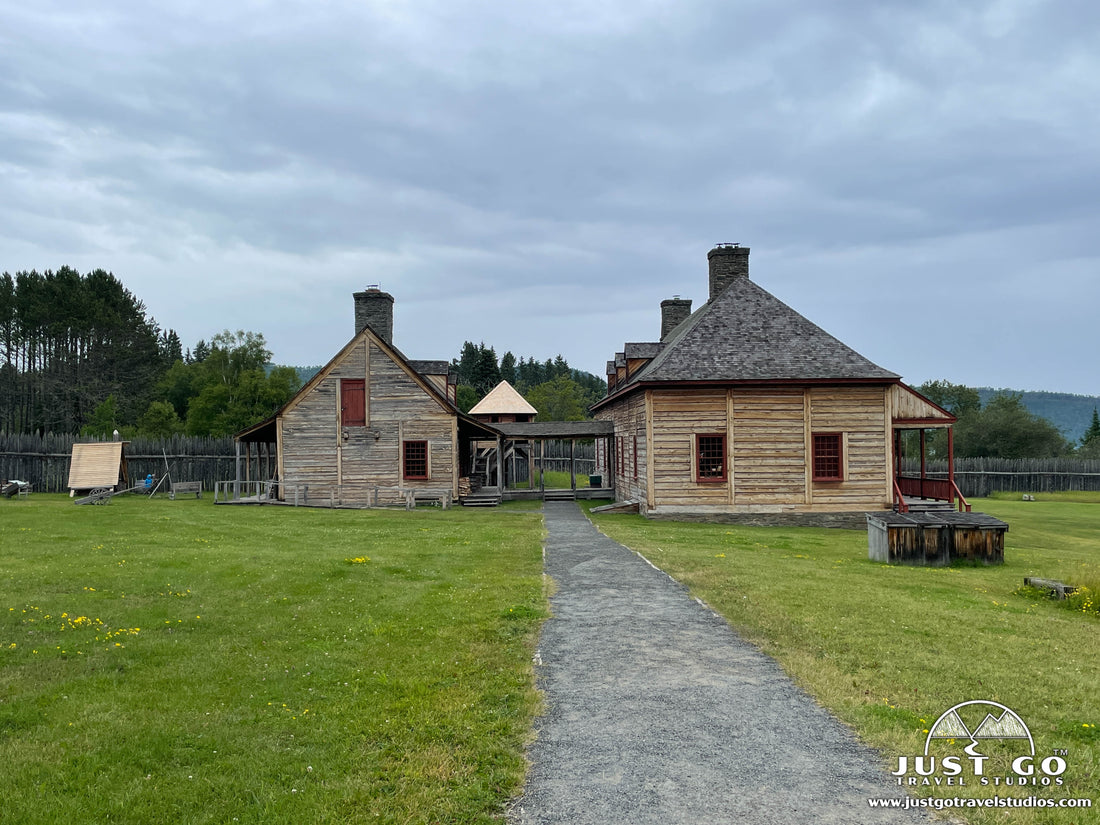
Grand Portage National Monument: Things to Do, Hiking Trails, Camping, Maps & More
Peter BrahanLocated in the far northern coastline along Lake Superior in Minnesota, Grand Portage National Monument is an unexpectedly beautiful collection of history, stories, land and buildings that chronicles this critical trade route for furs from the 1600’s to the early 1800’s by the North West Company.
Located nearby the Minnesota launching point for Isle Royale National Park (just north of Grand Marais, MN), Grand Portage National Monument celebrates the culture of the Grand Portage Ojibwe as well.
While you may not be heading up to this part of Minnesota for the sole purpose of going to Grand Portage National Monument, it is definitely worth a stop, and perhaps even spending the better part of a day or two exploring the area and learning about the culture. Our family was shocked at the facilities and the stories that were told by the park staff, exhibits and volunteers, and we’re sure you’ll be too. Plus, the facilities are on some beautiful grounds which are impeccably maintained.
With any luck, our guide here will help motivate you to go, but also inform you about how best to your time in the park, no matter how long you have!
GRAND PORTAGE NATIONAL MONUMENT HISTORY
It’s no secret that the fur trade was a huge economic driver in the early development of North America. Fur harvested in the winter in the Americas was in high demand in Europe. The fur had to get to Europe somehow, and that was typically on the backs (both literally and metaphorically) of the French-Canadian voyageurs. The routes were hundreds of miles long, if not thousands, as determined by the distance a crew could travel in a single season when the waters weren’t frozen.
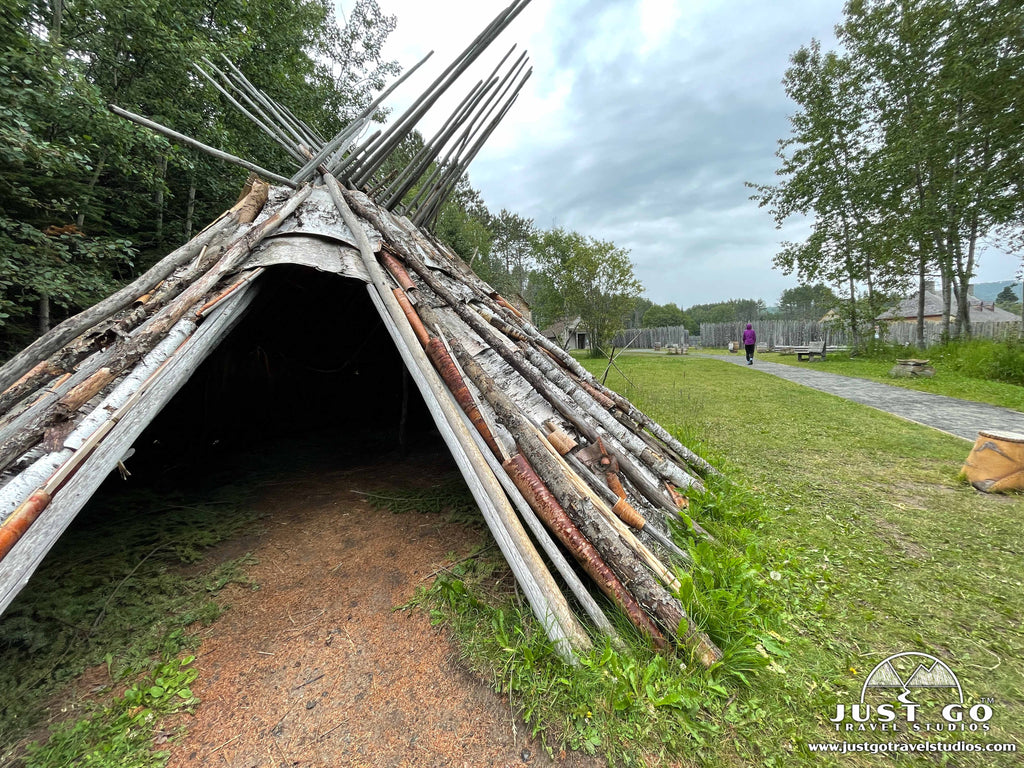
Travel by water was preferred, but when the waters were too rough, the voyageurs would “portage” the canoes and freight over land. The “Grand Portage” itself is an 8.5-mile path that bypasses the area’s waterfalls and rapids of the Pigeon River that flow into Lake Superior. That made this location an ideal spot for a summer headquarters of the company that ran the fur trade, the North West Company.
18 buildings were erected while this was the headquarters. However, in 1795, when the Revolutionary War officially ended, trade was complicated by the fact that the headquarters was located in the United States. In 1802, the North West Company decided to move its headquarters to Fort William, Ontario, Canada. By the 1820s, not much was left of the headquarters.
The Grand Portage National Historic Site was established over 100 years later (in 1951), and Grand Portage National Monument was designated in 1958. Today, just shy of 90,000 visitors a year come to the monument.
The buildings that exist today are replicas of the buildings that once were. The monument is just over 700 acres, with only the southeast portion of the monument reachable by vehicle. The rest is reached by either hiking or (you guessed it!) portaging.
THINGS TO DO IN GRAND PORTAGE NATIONAL MONUMENT
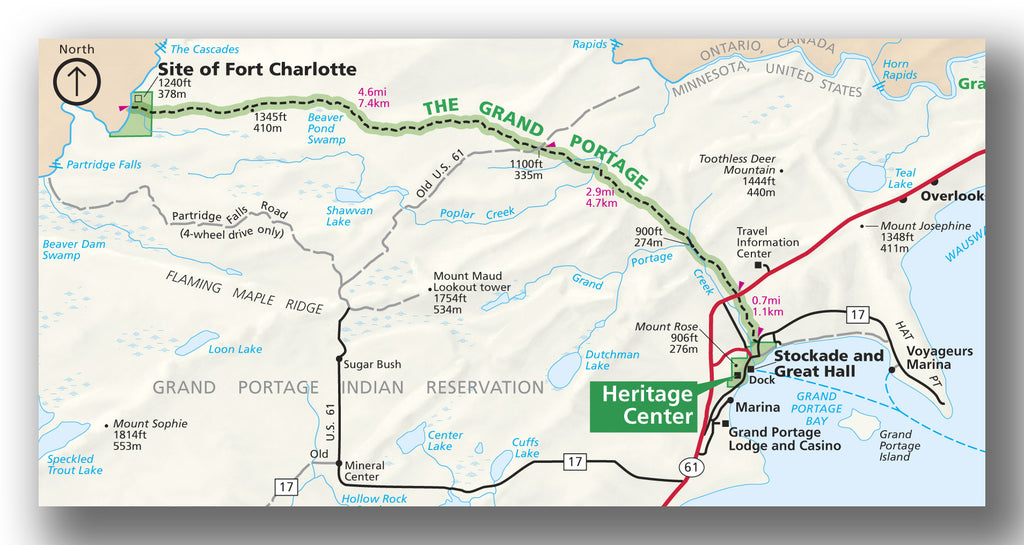
Grand Portage National Monument, courtesy of the National Park Service
Activities in Grand Portage National Monument largely center around learning about the history and walking the grounds of the old North West Company headquarters. But rest assured, for those that generally like to spend their time outdoors when visiting public lands, there is plenty to do here for you as well!
When visiting Grand Portage National Monument, the activities that we recommend include:
Grand Portage National Monument Heritage Center
Built in 2007, the Heritage Center is a collection of information, artifacts and stories that tell about the Ojibwe culture as well as the fur trade that was so active in this area of Minnesota. The 16,000+ square foot facility is one of the most beautiful centers that we’ve visited in the National Park Service units. The displays of the artifacts can keep you busy for hours, and there are park videos that you can take in as well.

Visit the Stockade (Depot Area) and Great Hall
Adjacent to the Heritage Center is the large stockade area, which served as the headquarters for the North West Company. Here you will find several different areas that are worth checking out:
- As you enter the Stockade area, you’ll first pass by the Ojibwe Village. This small area contains outdoor exhibits including shelters, gardens and tools used by the local people.
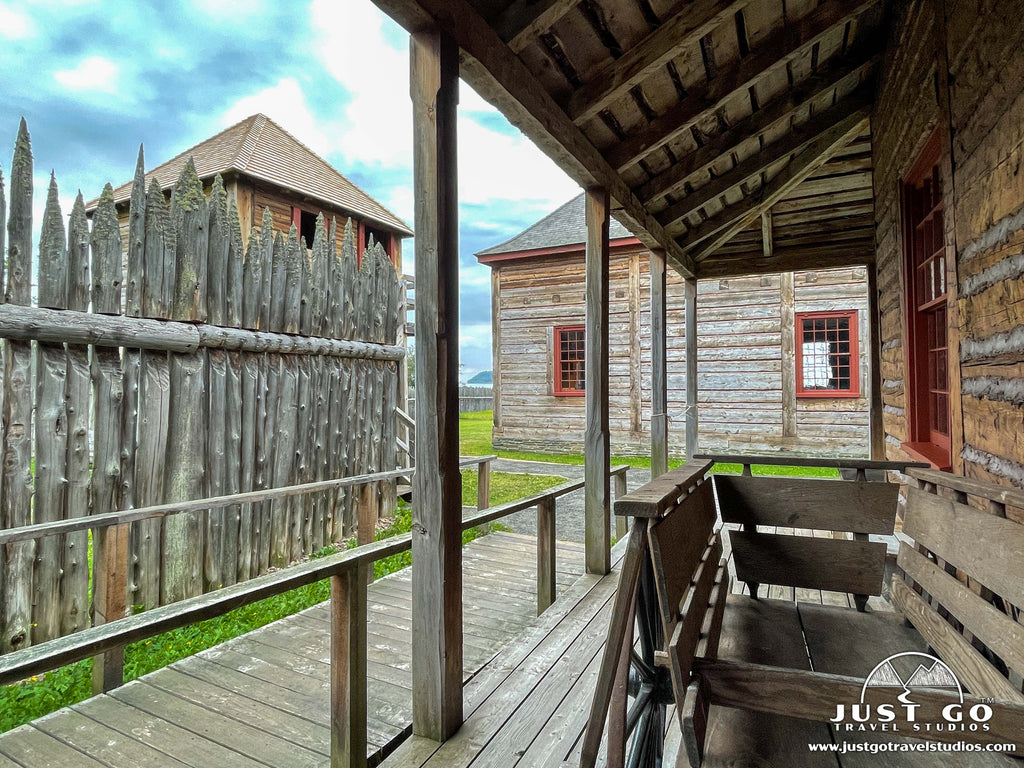
- Keep waking a short distance and you’ll get to the Canoe Warehouse. This long, narrow building contains beautiful watercraft on display, as well as interpreters that will help you understand the tools and techniques used for building canoes.


- Head into the Kitchen, which is where food was prepared for workers at the site.
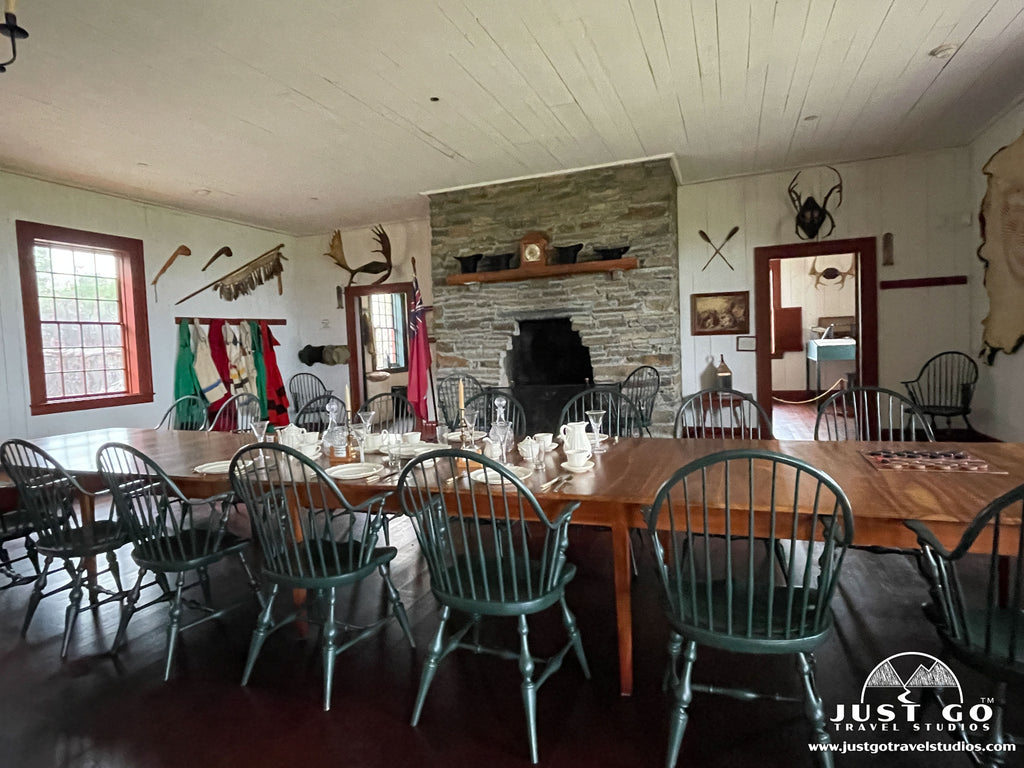
- Finally, the Great Hall is the largest (and many consider it the most impressive) structure on the site. Here you can see where the staff dined, as well as where they slept.
Hiking
We generally like to hike to really explore a park site. While most of the attraction of Grand Portage National Monument is walking the headquarters, there are still a few good hikes to consider, which we cover in detail in the next section.
HIKING TRAILS IN GRAND PORTAGE NATIONAL MONUMENT
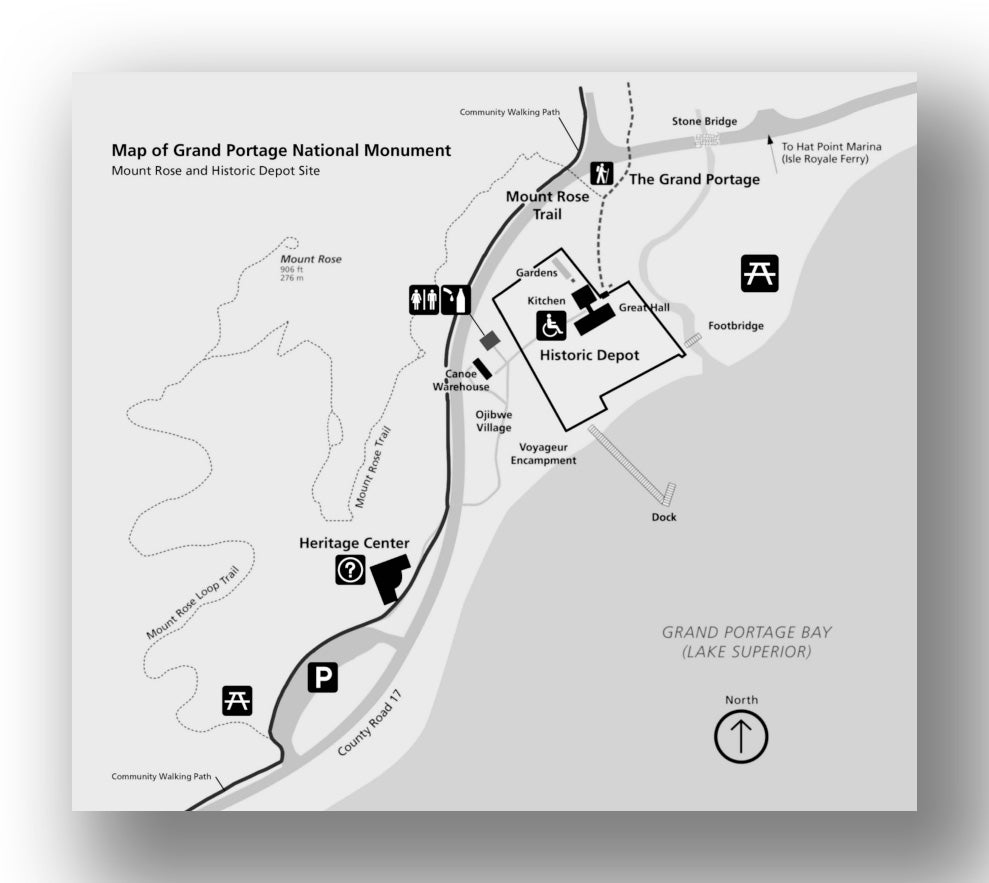
Grand Portage National Monument hiking map, courtesy of the National Park Service
Mount Rose Trail
- Difficulty: Easy / Moderate
- Distance (round-trip): 1.2 miles
- Elevation gain: 290 feet
- Hiking time (approximate): 45 minutes
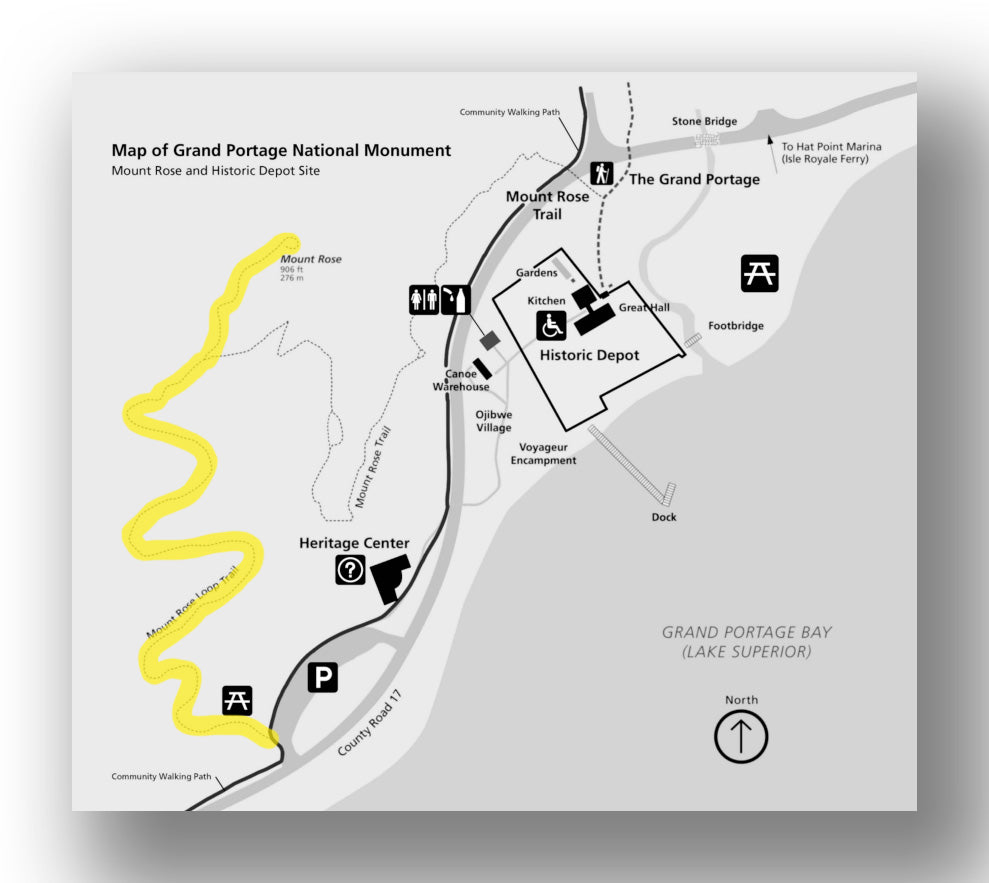
Mount Rose Trail map, courtesy of the National Park Service
Hike the Mount Rose Trail if you’d like a relatively easy hike to a great overlook. This easy/med trail leaves from the southern end of the parking lot for the Heritage Center and travels due east for a short period of time before turning north. The trail climbs nearly 300 feet over the first 0.3-miles before stopping at Mount Rose. You can turn back from here, or complete the loop by heading to the north (and behind the Heritage Center). This makes the entire hike about 1.2-miles (total) and comes back by way of the Stockade / Depot area.
The trailhead starts at the southeastern end of the Heritage Center Parking lot.
The Grand Portage
- Difficulty: Hard
- Distance (round-trip):6 miles
- Elevation gain: 1050 feet
- Hiking time (approximate): 2 days

Grand Portage Trail map, courtesy of the National Park Service
If you are up for more of an adventure, then the 16.6-mile (round-trip) hike along the Grand Portage may be for you! The trail gains about 1000 feet as you retrace the steps of voyageurs all the way to the Canadian border at Fort Charlotte. Most of the elevation gain happens in the first 4 miles. You need a permit, but you can camp at the rustic Fort Charlotte campsite and make this a two-day adventure. You can also shorten the trail and just take the boardwalk, which is about 1.5-miles (round-trip).
WHAT IS THERE TO DO NEAR GRAND PORTAGE NATIONAL MONUMENT?
If you are up in this area, then you likely are either passing through to Thunder Bay into Canada, or you are visiting to head to the other nearby parks as well. Our recommendations include:
- Visit Isle Royale National Park. This requires a full-day (at a minimum), but you can take a boat out to Isle Royale. This is the least visited National Park in the lower 48 states, but is totally worth the effort if you are out here. You can also download our Isle Royale National Park itinerary to learn more about the park!
- Another great place to visit to the north is Grand Portage State Park. Here you can take a short hike to Minnesota’s highest (and quite impressive!) waterfall, the aptly named High Falls. Grand Portage State Park is located right on the Canadian border, about 6 miles to the north of the National Monument.
- Just to the south is Judge C.R. Magney State Park. Here you can camp and also take a moderately challenging hike to additional amazing waterfalls. We stayed here and loved it! Judge C.R. Magney State Park is located about 22 miles to the south.
CAMPING IN GRAND PORTAGE NATIONAL MONUMENT
The only type of camping offered in Grand Portage National Monument is backcountry camping when hiking on the Grand Portage. Though remote, you’ll get the experience of camping where the voyageurs from hundreds of years ago camped! You do need to have a free backcountry permit. You can also camp at local state parks, including Judge C.R. Magney State Park.
HOW TO GET TO GRAND PORTAGE NATIONAL MONUMENT AND OTHER TRAVEL INFORMATION
Though Grand Portage National Monument isn’t a destination for many by itself, there is quite a lot of traffic that drives right by it when heading to or from the nearby border crossing at Thunder Bay, ON. It’s easy to get to from the main road, and we do recommend that you stop!
- Here are the directions from Thunder Bay, ON to Grand Portage National Monument. It will take a bit less than an hour for this drive, including the border crossing.
- Coming from the south? Here are directions from Duluth, MN to Grand Portage National Monument. This will take just under 3 hours.
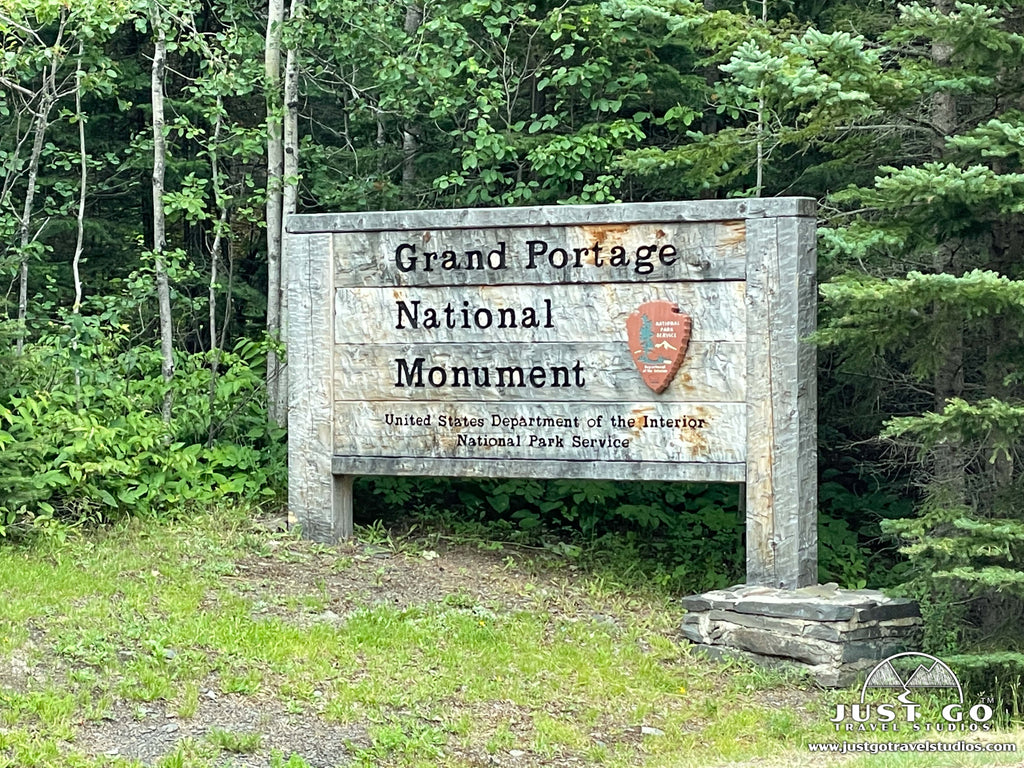
ENTRANCE FEES AND REQUIRED PASSES FOR GRAND PORTAGE NATIONAL MONUMENT
There is no cost to visit Grand Portage National Monument.
BEST TIME TO VISIT GRAND PORTAGE NATIONAL MONUMENT
Most people think that the best time to visit Grand Portage National Monument is in the summer, and we’d agree. This is when all the exhibits are open and trails are easiest to enjoy. Be prepared for cool temperatures (even in the summer), and bugs will be around if you come in the early summer in particular.
VISITING GRAND PORTAGE NATIONAL MONUMENT IN THE WINTER
You can absolutely visit in the winter! Snowshoeing is popular, and you can borrow them from the Heritage Center. It is very, very cold though, so be prepared!
ARE PETS ALLOWED IN GRAND PORTAGE NATIONAL MONUMENT?
Pets are welcome at the park, with the exception of the Stockade / Depot area and the Heritage Center. Pets are required to be leashed at all times.
RELATED INFORMATION ON GRAND PORTAGE NATIONAL MONUMENT SURROUNDING AREA FROM JUST GO TRAVEL STUDIOS
- Ahead of your trip, you also may want to consider visiting Isle Royale National Park nearby. Download our Isle Royale National Park itinerary if you have any interest!
- Be sure to also check out our blog on Things to Do and Hiking Trails in Judge CR Magney State Park.
- Upon returning from your amazing adventures to Minnesota, be sure to send us a photo. We’ll take it, along with your custom wording and create a custom, vintage travel poster. This will help you remember your trips forever, and bring you back to that special time when you had your amazing vacation!


